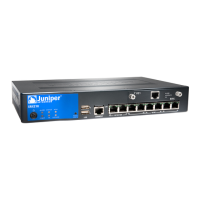Page 5
Task 4: Configure the SIP Station
NOTE: For initial configuration of the device, you do not need to configure the station
templates. You can use the default values.
1. Select Configure > Convergence Services > Station. The Station Configuration
page appears.
2. Click Add to add the new station, and perform the following mandatory basic
actions:
NOTE: You can configure the analog templates to be similar so that they can share a
common configuration.
NOTE: You can use station templates to configure stations so that they share a common
configuration. By default, templates are available for both SIP and analog stations. For
SIP stations, the extension range is 5001 through 5016.
Task 5: Configure the Analog Station
1. Select Configure > Convergence Services > Station. The Station Configuration
page appears.
2. Click Add to add the new station, and perform the following mandatory basic
actions:
You can configure the individual SIP stations similarly so that they can share a common
configuration.
NOTE: By default, templates are available for both SIP and analog stations.
Task 6: Configure the Peer Call Server
Configure the peer call server that provides call routing and call handling services for the
branch as long as it is accessible:
1. Select Configure > Convergence Services > Call Server. The Peer Call Server
Configuration page appears.
2. Perform the following mandatory basic actions:
When configuring the peer call server:
For the device to authenticate itself with the peer call server, you might need to
provide the device user ID and password details as provided by the peer call
server’s administrator.
You can accept the default values in the Port (5060) and Transport (UDP) fields.
For initial configuration of the device, you do not need to specify the codec. The
default set of codecs is used. By default, codecs are specified in the following order:
711-µ, G711-A, G729AB
Task 7: Configure a Trunk
Configure a trunk for a PSTN time-division multiplexing (TDM) interface to be used by
the device or the survivable call server to route calls to the destination.
1. Select Configure > Convergence Services > Gateway > Trunks. The New Trunk
Configuration page appears.
2. Perform the following actions:
NOTE: By default, the two onboard FXO ports are configured as part of a default group
called the Branch_Trunk_Group, which will enable you to make calls using the FXO trunk
ports.
Task 8: Configure the Trunk Groups
A trunk group comprises multiple trunks specified in the order of precedence in which
they must be selected to route a call.
1. Select Configure > Convergence Services > Gateway > Trunk Groups. The
Trunk Group Configuration page appears.
2. Click Add to create a new trunk group and perform the following mandatory actions:
Field Action
Name Specify a name for the station.
Extensions Enter the extension number of the station.
Class of Restriction Select the already configured class of restriction.
Template Name Select the already defined station template.
Field Action
Name Specify a name for the station.
Extensions Enter the extension number of the station.
Class of Restriction Select the already configured class of restriction.
Template Name Select the already defined station template. In
addition, the default extensions are also configured for
the two onboard FXS ports.
TDM Interface Specify the type of TDM interface to be configured
(FXO, FXS, or T1).
Field Action
Name Specify the name for the peer call server.
PSTN Access Number Specify the external PSTN number for the survivable
call server to use if it must contact the PSTN directly.
Address Type Select the address type as either fqdn or
ipv4-address.
FQDN Enter the fully qualified domain name.
IP Address Enter the IP address of the peer call server.
Field Action
Trunk Name Enter a name for the trunk
Trunk Type Select the trunk type (FXO, FXS, or T1).
TDM Interface Select the type of TDM interface to be configured
(FXO, FXS, or T1) for routing certain types of calls.
Field Action
Name Specify a name for the trunk group.
Available Trunks Select the trunks applicable to your setup.

